Lyons W.C. (ed.). Standard handbook of petroleum and natural gas engineering.2001- Volume 1
Подождите немного. Документ загружается.

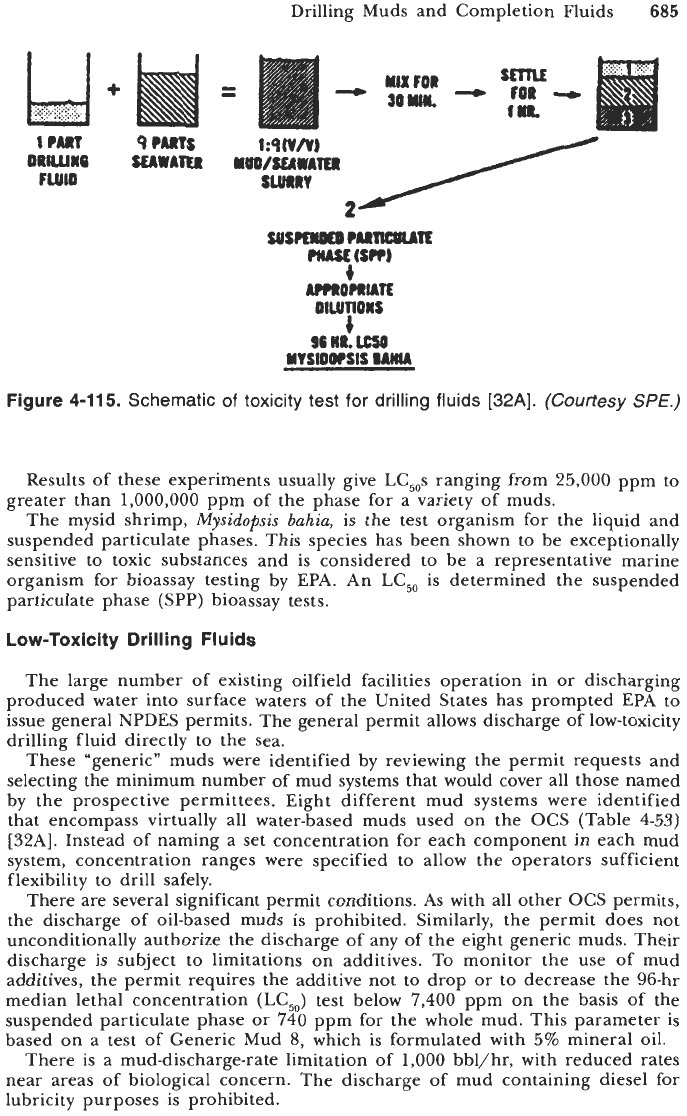
Drilling Muds and Completion Fluids
685
1?MT
9
?MfS
1:9(V/VJ
ORIUNQ
SEAWATER
IIW/SEAWAIIEI
fUllO
SLURRY
2
suS~?AuTICmA~
Mt
W?J
+
A??Romun
OlWnOls
t
96
#R.
LMO
YIS10WSIS
BAmA
Figure 4-115.
Schematic of toxicity test for drilling fluids
[32A].
(Courtesy
SPE.)
Results of these experiments usually give LC,,s ranging from
25,000
pprn to
greater than
1,000,000
pprn of the phase for a variety of muds.
The mysid shrimp,
Mysidopsis
bahiu,
is the test organism for the liquid and
suspended particulate phases. This species has been shown to be exceptionally
sensitive to toxic substances and is considered to be a representative marine
organism for bioassay testing by EPA. An LC,, is determined the suspended
particulate phase (SPP) bioassay tests.
Low-Toxicity Drilling Fluids
The large number of existing oilfield facilities operation in or discharging
produced water into surface waters of the United States has prompted EPA to
issue general NPDES permits. The general permit allows discharge of low-toxicity
drilling fluid directly to the sea.
These "generic" muds were identified by reviewing the permit requests and
selecting the minimum number of mud systems that would cover all those named
by the prospective permittees. Eight different mud systems were identified
that encompass virtually all water-based muds used on the
OCS
(Table
4-53)
[32A]. Instead of naming a set concentration for each component in each mud
system, concentration ranges were specified to allow the operators sufficient
flexibility to drill safely.
There are several significant permit conditions. As with all other OCS permits,
the discharge of oil-based muds is prohibited. Similarly, the permit does not
unconditionally authorize the discharge of any of the eight generic muds. Their
discharge is subject to limitations on additives. To monitor the use of mud
additives, the permit requires the additive not to drop or to decrease the 96-hr
median lethal concentration (LC,,) test below
7,400
pprn on the basis of the
suspended particulate phase or
740
ppm for the whole mud. This parameter is
based on a test of Generic Mud
8,
which is formulated with
5%
mineral oil.
There is a mud-discharge-rate limitation of
1,000
bbl/hr, with reduced rates
near areas of biological concern. The discharge of mud containing diesel for
lubricity purposes is prohibited.
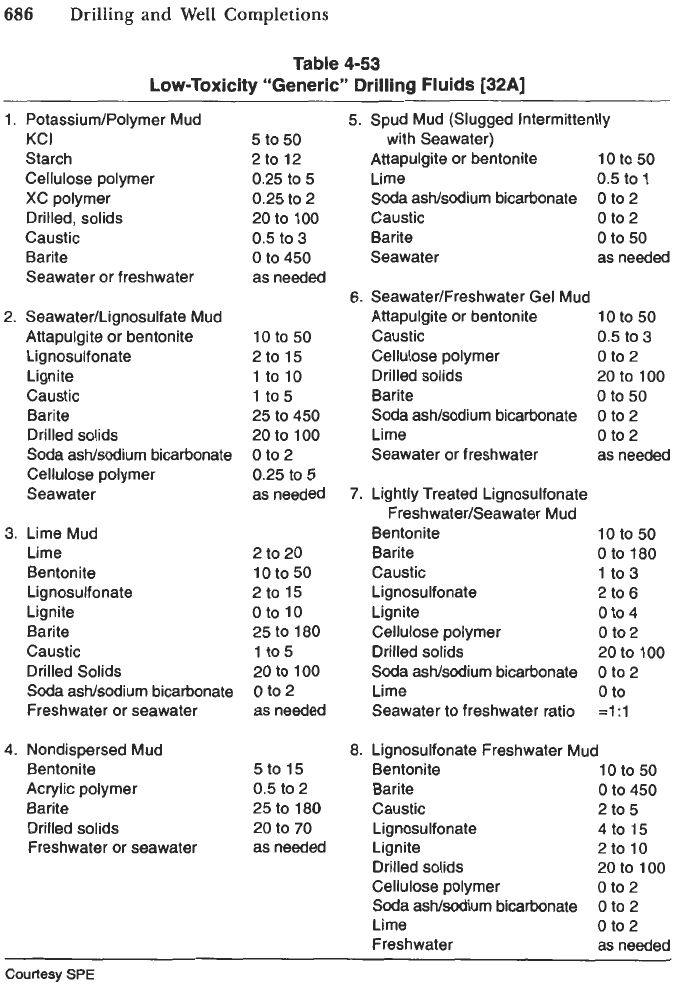
686
Drilling
and
Well
Completions
Table 4-53
Low-Toxicity
“Generic” Drilling Fluids
[32A]
PotassiumlPolymer Mud
KC
I
Starch
Cellulose polymer
XC polymer
Drilled, solids
Caustic
Barite
Seawater or freshwater
SeawaterlLignosulfate Mud
Attapulgite or bentonite
Lignosulfonate
Lignite
Caustic
Barite
Drilled solids
Soda ashlsodium bicarbonate
Cellulose polymer
Seawater
Lime Mud
Lime
Bentonite
Lignosulfonate
Lignite
Barite
Caustic
Drilled Solids
Soda ash/sodium bicarbonate
Freshwater or seawater
5 to 50
2
to
12
0.25 to 5
0.25 to
2
20 to
100
0.5 to
3
0
to 450
as
needed
10 to 50
2 to 15
1
to10
1 to5
25 to 450
20 to 100
0
to 2
0.25 to 5
as needed
2
to 20
10
to
50
2
to 15
0
to
10
25 to 180
1
to 5
20 to 100
0
to 2
as
needed
Nondispersed Mud
Bentonite 5to15
Acrylic polymer 0.5 to 2
Barite 25 to 180
Drilled solids
20
to
70
Freshwater or seawater as needed
5. Spud Mud (Slugged Intermittently
with Seawater)
Attapulgite or bentonite
10
to 50
Lime 0.5 to 1
Soda ashisodium bicarbonate
0
to 2
Caustic
0
to 2
Barite
0
to
50
Seawater as needed
6.
SeawateriFreshwater Gel Mud
Attapulgite or bentonite 10
to
50
Caustic 0.5 to
3
Cellulose polymer
0
to
2
Drilled solids
20
to 100
Barite
0
to 50
Soda ashisodium bicarbonate
0
to 2
Lime
0
to
2
Seawater or freshwater as needed
7.
Lightly Treated Lignosulfonate
FreshwaterISeawater Mud
Bentonite 10 to 50
Caustic 1 to
3
Lignosulfonate 2 to
6
Lignite
0
to
4
Cellulose polymer
0
to
2
Drilled solids 20 to
100
Soda asWsodium bicarbonate
Lime
0
to
Seawater
to
freshwater ratio =1:1
Barite
0
to
180
0
to
2
8.
Lignosulfonate Freshwater Mud
Bentonite
10
to 50
Barite
0
to 450
Caustic 2 to 5
Lignite 2to10
Drilled solids 20
to
100
Cellulose polymer
0
to 2
Soda ashlsodium bicarbonate
0
to 2
Lime
0
to 2
Freshwater
as
needed
Lignosulfonate 4 to 15
Courtesy
SPE
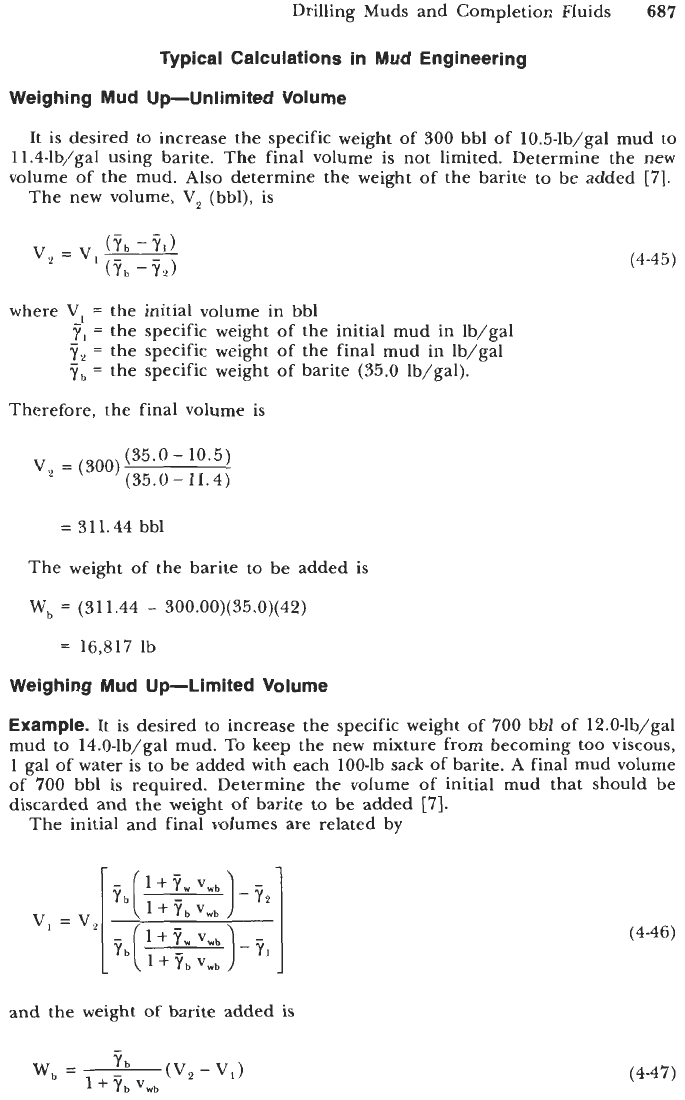
Drilling Muds and Completion Fluids
687
Typical Calculations In Mud Engineering
Weighing Mud Up-Unlimited Volume
It is desired to increase the specific weight of
300
bbl of 10.5-lb/gal mud to
11.4-lb/gal using barite. The final volume is not limited. Determine the new
volume
of
the mud. Also determine the weight
of
the barite to be added [7].
The new volume,
V,
(bbl), is
(4-45)
where V,
=
the initial volume in bbl
7,
=
the specific weight of the initial mud in lb/gal
7,
=
the specific weight of the final mud
in
lb/gal
7,
=
the specific weight of barite (35.0 lb/gal).
Therefore, the final volume is
(35.0
-
10.5)
(35.0-11.4)
V,
=
(300)
=
311.44 bbl
The weight of the barite to be added is
Wb
=
(311.44
-
300.00)(35.0)(42)
=
16.817 lb
Weighing Mud Up-Limited Volume
Example.
It is desired to increase the specific weight of
700
bbl of 12.0-lb/gal
mud to 14.0-lb/gal mud. To keep the new mixture from becoming too viscous,
1
gal of water is to be added with each 100-lb sack of barite.
A
final mud volume
of
700
bbl
is
required. Determine the volume of initial mud that should be
discarded and
the
weight
of
barite to be added
171.
The initial and final volumes are related by
and the weight of barite
added
is
(4-46)
(4-47)
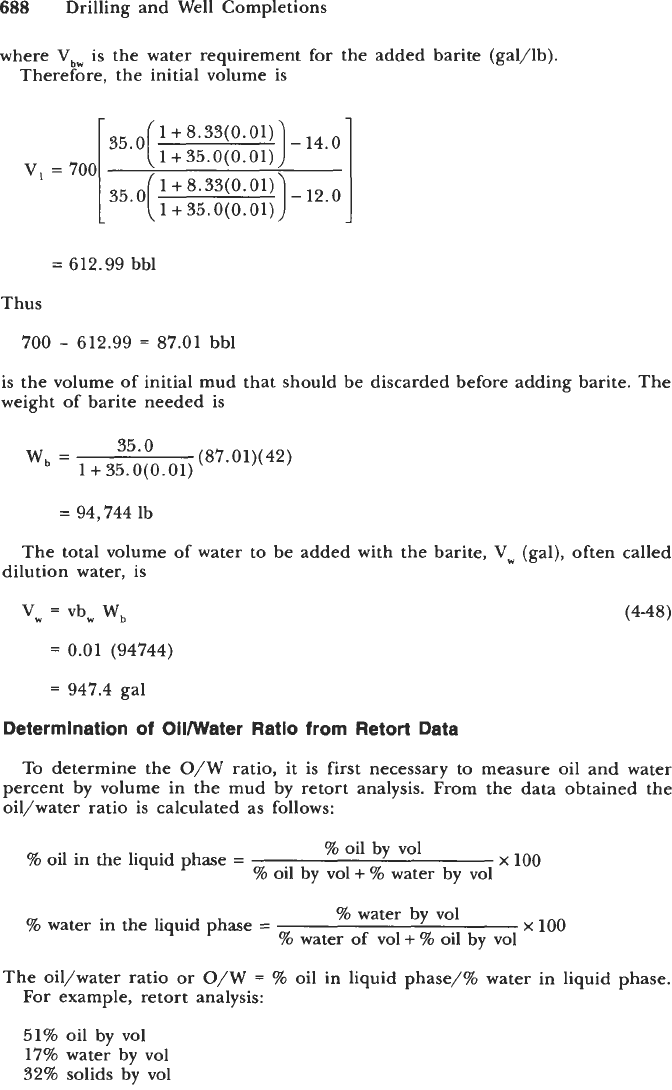
688
Drilling and Well Completions
where
VbW
is the water requirement for the added barite (gal/lb).
Therefore, the initial volume is
v,
=
1+8.33(0.01)
-14.0
1
+35.0(0.01)
I
7001 35.0(
35.0(
1
+
35.0(0.01)
=
612.99
bbl
Thus
700
-
612.99
=
87.01
bbl
is the volume of initial mud that should be discarded before adding barite. The
weight of barite needed is
w,
=
35'0
(87.01)(42)
1
+
35.0(0.01)
=
94,744
lb
The total volume of water to be added with the barite,
Vw
(gal), often called
dilution water, is
Vw
=
vbw W,
=
0.01 (94744)
(4-48)
=
947.4
gal
Determlnation
of
OIlMlater Ratio from Retort Data
To determine the
O/W
ratio, it is first necessary to measure oil and water
percent by volume in the mud by retort analysis. From the data obtained the
oil/water ratio is calculated as follows:
%
oil by vol
%
oil by vol
+
%
water by vol
%
oil in
the
liquid phase
=
x
100
%
water by vol
%
water
of
vol+
%
oil by vol
%
water in the liquid phase
=
x
100
The oil/water ratio or O/W
=
%
oil in liquid phase/% water in liquid phase.
For example, retort analysis:
51%
oil by vol
17%
water by vol
32%
solids by vol
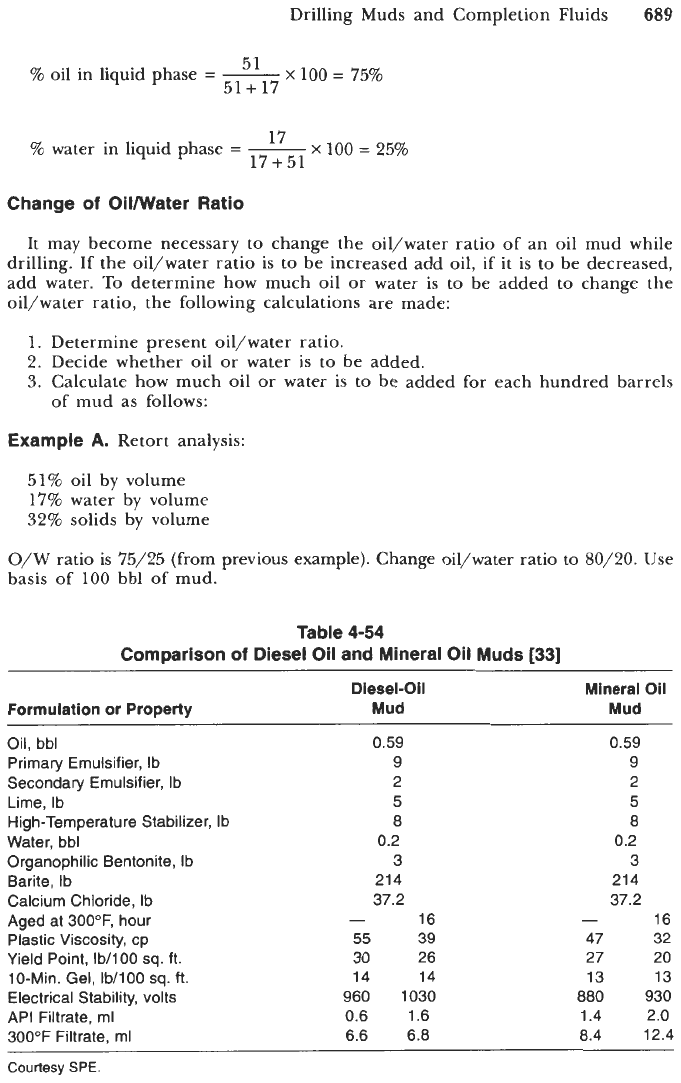
Drilling
Muds
and Completion Fluids
689
%
oil in liquid phase
=
-
51
x100= 75%
51
+
17
%
water in liquid phase
=
-
l7
x100=25%
17
+
51
Change
of
OilMlater Ratio
It may become necessary to change the oil/water ratio of an oil mud while
drilling. If the oil/water ratio is to be increased add oil, if
it
is to be decreased,
add water.
To
determine how much oil or water
is
to be added to change the
oil/water ratio, the following calculations are made:
1. Determine present oil/water ratio.
2. Decide whether oil or water
is
to be added.
3.
Calculate how much oil or water is to be added for each hundred barrels
of mud as follows:
Example
A.
Retort analysis:
51% oil by volume
17% water by volume
32% solids by volume
O/W
ratio is 75/25 (from previous example). Change oil/water ratio to 80/20. Use
basis of
100
bbl of mud.
Table
4-54
Comparison
of
Diesel Oil and Mineral
Oil
Muds
[33]
Diesel-Oil Mineral Oil
Formulation or Property
Mud Mud
Oil,
bbl
0.59 0.59
Primary Emulsifier,
Ib
9
9
Secondary Emulsifier, Ib
2 2
Lime,
Ib
5 5
Water, bbl
0.2 0.2
Organophilic Bentonite,
Ib
3 3
Aged at
3OO0F,
hour
-
Yield Point, lb/100 sq. ft.
30 26 27
20
High-Temperature Stabilizer,
Ib
8 8
Barite, Ib
214 214
Calcium Chloride,
Ib
37.2 37.2
16
Plastic Viscosity, cp
55
39
47
32
10-Min. Gel,
lb/lOO
sq.
ft.
14 14
13 13
Electrical Stability,
volts
960 1030 880 930
API Filtrate, ml
0.6 1.6
1.4 2.0
300°F
Filtrate, ml
6.6 6.8
8.4 12.4
-
16
Courtesy
SPE.
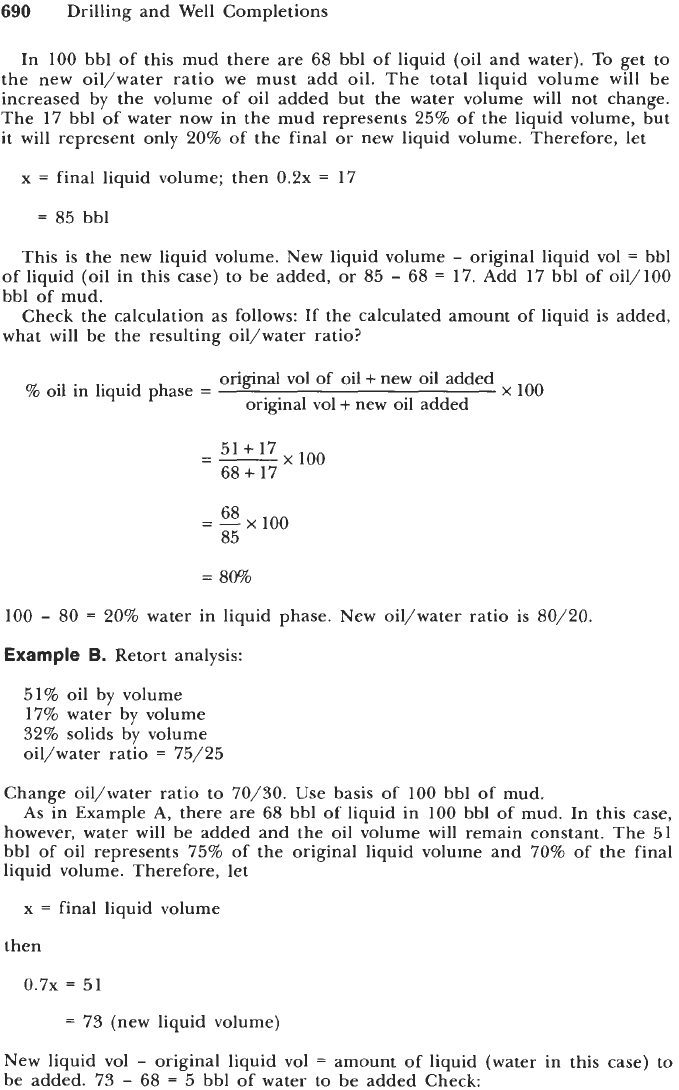
690
Drilling and Well Completions
In
100
bbl of this mud there are 68 bbl of liquid (oil and water).
To
get to
the new oil/water ratio we must add oil. The total liquid volume will be
increased by the volume of oil added but the water volume will not change.
The 17 bbl of water now in the mud represents 25% of the liquid volume, but
it
will
represent only 20% of the final or new liquid volume. Therefore, let
x
=
final liquid volume; then 0.2~
=
17
=
85 bbl
This is the new liquid volume. New liquid volume
-
original liquid vol
=
bbl
of liquid (oil in this case) to be added, or 85
-
68
=
17. Add 17 bbl of oi1/100
bbl of mud.
Check the calculation as follows: If the calculated amount of liquid is added,
what
will
be the resulting oil/water ratio?
original vol of oil
+
new oil added
original vol
+
new oil added
%
oil in liquid phase
=
x
100
-- -
51+17
xlOO
68+17
--
-
68
x
100
85
=
80%
100
-
80
=
20% water in liquid phase. New oil/water ratio is 80/20.
Example
B.
Retort analysis:
51% oil by volume
17% water by volume
32% solids by volume
oil/water ratio
=
75/25
Change oil/water ratio to 70/30. Use basis of
100
bbl of mud.
As
in Example
A,
there are 68 bbl
of
liquid in 100 bbl of mud. In this case,
however, water will be added and the oil volume will remain constant. The 51
bbl
of
oil represents 75% of the original liquid volume and
70%
of the final
liquid volume. Therefore, let
x
=
final liquid volume
then
0.7~
=
51
=
73 (new liquid volume)
New liquid vol
-
original liquid vol
=
amount
of
liquid (water in this case) to
be added. 73
-
68
=
5 bbl
of
water to be added Check:
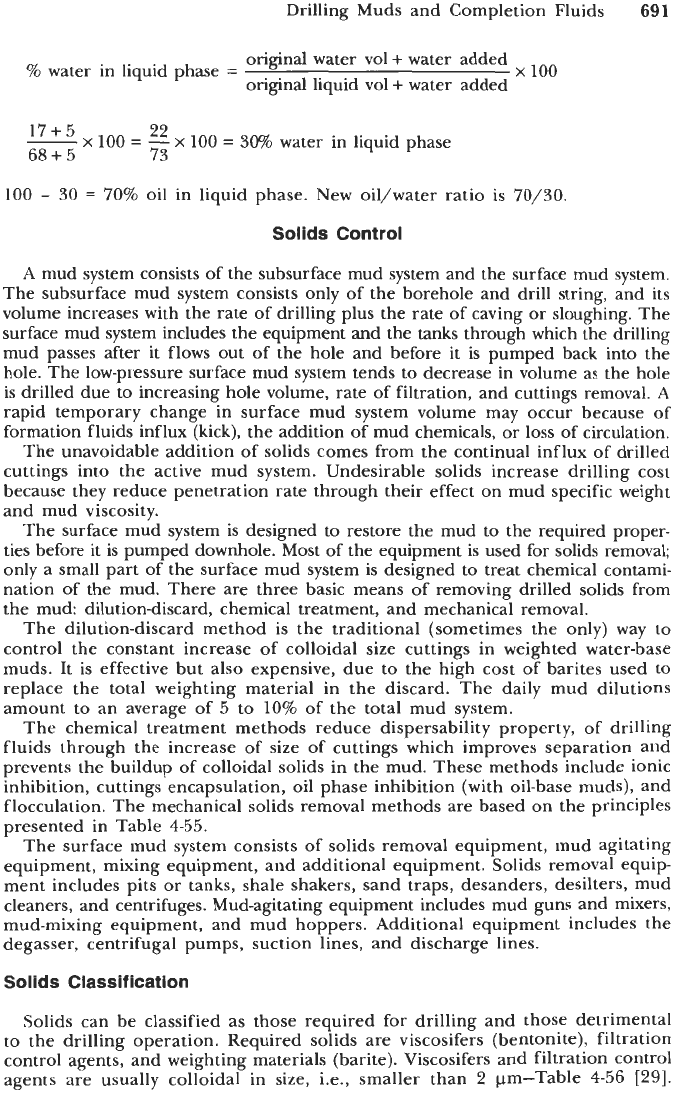
Drilling Muds and Completion Fluids
691
original water vol
+
water added
original liquid vol
+
water added
%
water in liquid phase
=
x
100
22
l7
+
68+5
73
x
100
=
-
x
100
=
30%
water in liquid phase
100
-
30
=
70% oil in liquid phase. New oil/water ratio
is
70/30.
Solids
Control
A
mud system consists of the subsurface mud system and the surface mud system.
The subsurface mud system consists only of the borehole and drill string, and
its
volume increases with the rate of drilling plus the rate of caving or sloughing. The
surface mud system includes the equipment and the tanks through which the drilling
mud passes after it flows out of the hole and before it is pumped back into the
hole. The low-pressure surface mud system tends to decrease in volume as the hole
is drilled due to increasing hole volume, rate of filtration, and cuttings removal.
A
rapid temporary change in surface mud system volume may occur because
of
formation fluids influx (kick), the addition of mud chemicals, or loss of circulation.
The unavoidable addition of solids comes from the continual influx of drilled
cuttings into the active mud system. Undesirable solids increase drilling cost
because they reduce penetration rate through their effect on mud specific weight
and mud viscosity.
The surface mud system is designed
to
restore the mud to the required proper-
ties before it is pumped downhole. Most of the equipment is used for solids removal;
only a small part of the surface mud system
is
designed to treat chemical contami-
nation of the mud. There are three basic means of removing drilled solids from
the mud: dilution-discard, chemical treatment, and mechanical removal.
The dilution-discard method is the traditional (sometimes the only) way to
control the constant increase of colloidal size cuttings in weighted water-base
muds. It is effective but also expensive, due to the high cost of barites used to
replace the total weighting material in the discard. The daily mud dilutions
amount to an average of
5
to
10%
of the total mud system.
The chemical treatment methods reduce dispersability property, of drilling
fluids through the increase of size of cuttings which improves separation and
prevents the buildup of colloidal solids in the mud. These methods include ionic
inhibition, cuttings encapsulation, oil phase inhibition (with oil-base muds), and
flocculation. The mechanical solids removal methods are based on the principles
presented in Table 4-55.
The surface mud system consists of solids removal equipment, mud agitating
equipment, mixing equipment, and additional equipment. Solids removal equip-
ment includes pits or tanks, shale shakers, sand traps, desanders, desilters, mud
cleaners, and centrifuges. Mud-agitating equipment includes mud guns and mixers,
mud-mixing equipment, and mud hoppers. Additional equipment includes the
degasser, centrifugal pumps, suction lines, and discharge lines.
Solids Classification
Solids can be classified as those required for drilling and those detrimental
to the drilling operation. Required solids are viscosifers (bentonite), filtration
control agents, and weighting materials (barite). Viscosifers and filtration control
agents are usually colloidal in size, i.e., smaller than
2
pm-Table 4-56
[29].
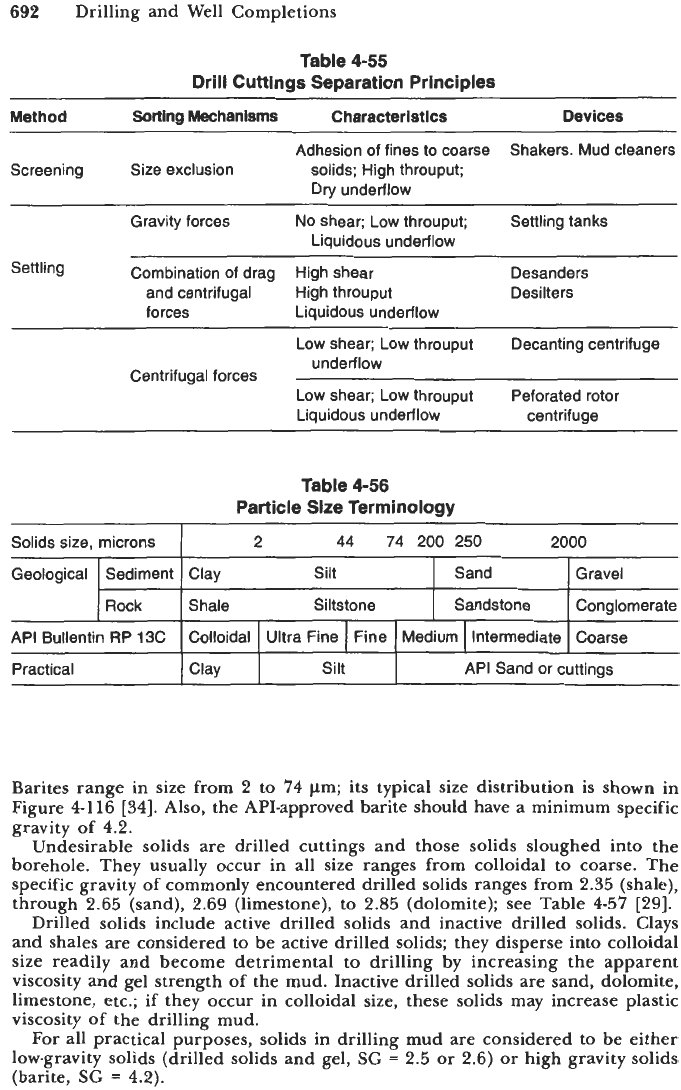
692
Drilling and Well Completions
Solids size, microns
Geological Sediment
Rock
API
Bullentin
RP
13C
Practical
Table
4-55
Drill Cuttings Separation Principles
2
44 74
200
250
2000
Clay Silt Sand Gravel
Shale Siltstone Sandstone Conglomerate
Colloidal Ultra Fine Fine Medium Intermediate Coarse
Clav Silt API Sand or cuttinas
Method
Sortina
Mechanisms Characteristics Devices
Adhesion of fines to coarse
Shakers. Mud cleaners
Screening Size exclusion solids: High throuput;
Dry underflow
Gravity forces
No
shear; Low throuput; Settling tanks
Liquidous underflow
Settling Combination of drag High shear Desanders
and centrifugal High throuput Desilters
forces Liquidous underflow
~~
Low shear; Low throuput
Decanting centrifuge
underflow
Centrifugal forces
Low shear; Low throuput
Peforated rotor
Liquidous underflow centrifuge
Barites range in size from
2
to
74
pm; its typical size distribution is shown in
Figure
4-1
16
[34].
Also, the API-approved barite should have a minimum specific
gravity
of
4.2.
Undesirable solids are drilled cuttings and those solids sloughed into the
borehole. They usually occur in all size ranges from colloidal to coarse. The
specific gravity
of
commonly encountered drilled solids ranges from
2.35
(shale),
through
2.65
(sand),
2.69
(limestone), to
2.85
(dolomite); see Table
4-57
[29].
Drilled solids include active drilled solids and inactive drilled solids. Clays
and shales are considered
to
be active drilled solids; they disperse into colloidal
size readily and become detrimental to drilling by increasing the apparent
viscosity and gel strength
of
the mud. Inactive drilled solids are sand, dolomite,
limestone, etc.;
if
they occur in colloidal size, these solids may increase plastic
viscosity of the drilling mud.
For all practical purposes, solids in drilling mud are considered to be either
low-gravity solids (drilled solids and gel,
SG
=
2.5
or
2.6)
or high gravity solids
(barite,
SG
=
4.2).
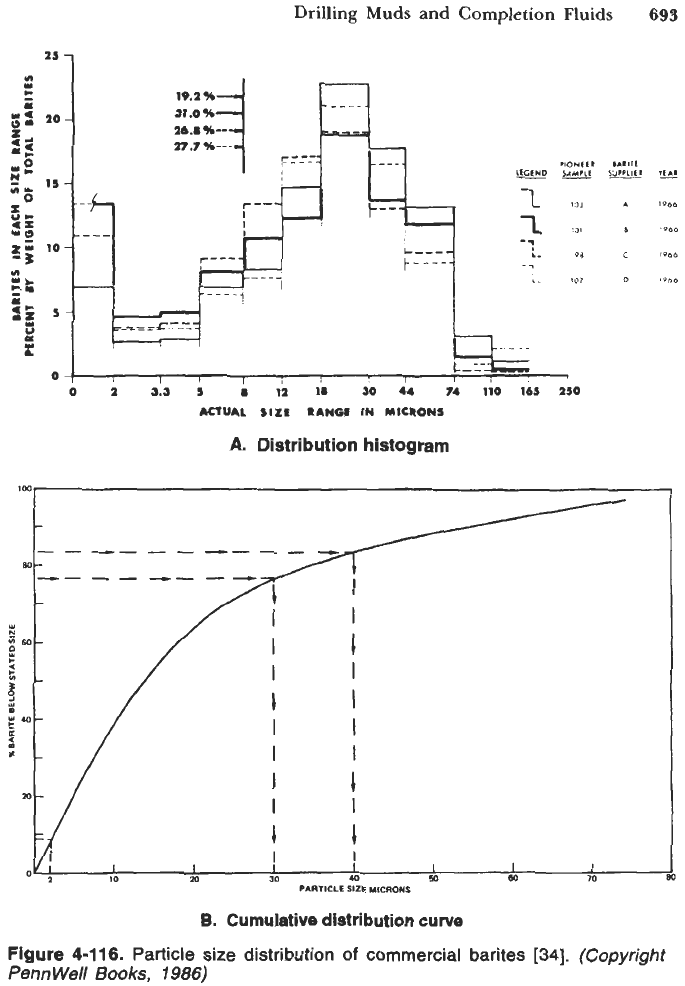
Drilling Muds and Completion
Fluids
693
15
1
20
15b
10
L.
0,
I
I
I
I
1,
I
I
I.
0
1
3.3
$
0
12
IO
30
44
74
110
165 250
ACTUAL
SILL
RANW
IN
MICRONS
A.
Distribution histogram
I--
-
-
--
I
I
I
I
I
I
I
I
I
I
1
I
I
m
50
40
50
0
70
PARTICLE
SIZE
MICRCUP
10
8.
Cumulative distribution curve
Figure
4-116.
Particle size distribution
of
commercial barites
[34].
(Copyright
Penn
Well
Books,
1986)
3
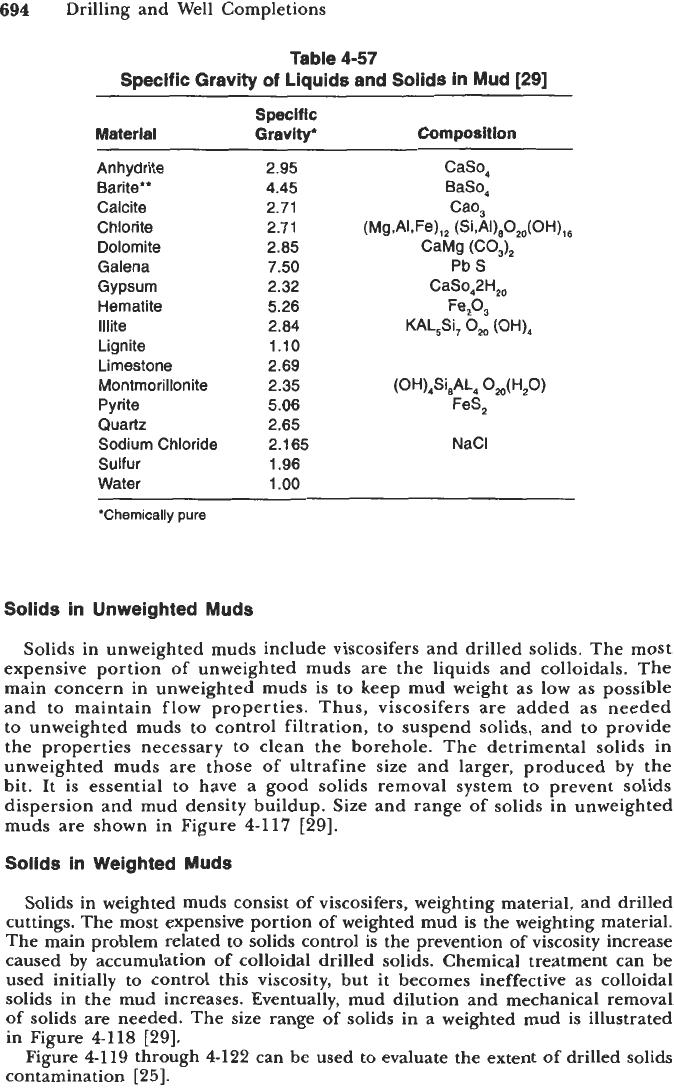
694
Drilling and Well Completions
Table
4-57
Specific
Gravity
of
Liquids and Solids in
Mud
[29]
Material
Specific
Gravity'
Composition
Anhydrite
Barite"
Calcite
Chlorite
Dolomite
Galena
Gypsum
Hematite
Illite
Lignite
Limestone
Montmorillonite
Pyrite
Quartz
Sodium Chloride
Sulfur
Water
2.95
4.45
2.71
2.71
2.85
7.50
2.32
5.26
2.84
1.10
2.69
2.35
5.06
2.65
2.1 65
1.96
1
.oo
NaCl
'Chemically
pure
Solids in Unweighted
Muds
Solids in unweighted muds include viscosifers and drilled solids. The most
expensive portion
of
unweighted muds are the liquids and colloidals. The
main concern in unweighted muds is to keep mud weight as low as possible
and to maintain flow properties. Thus, viscosifers are added as needed
to unweighted muds to control filtration, to suspend solids, and to provide
the properties necessary to clean the borehole. The detrimental solids in
unweighted muds are those
of
ultrafine size and larger, produced by the
bit. It is essential
to
have a good solids removal system to prevent solids
dispersion and mud density buildup. Size and range
of
solids in unweighted
muds are shown in Figure
4-117
[29].
Solids in Weighted Muds
Solids in weighted muds consist of viscosifers, weighting material, and drilled
cuttings. The most expensive portion of weighted mud is the weighting material.
The main problem related to solids control is the prevention of viscosity increase
caused by accumulation
of
colloidal drilled solids. Chemical treatment can be
used initially to control this viscosity, but it becomes ineffective as colloidal
solids in the mud increases. Eventually, mud dilution and mechanical removal
of
solids are needed. The size range of solids in a weighted mud is illustrated
in Figure
4-118
[29].
Figure
4-119
through
4-122
can be used to evaluate the extent
of
drilled solids
contamination
[25].
